Here is a possible MATLAB solution.
1) Fake data
To test my code, I first had to generate some fake data resembling your actual one. You can skip this section when working with the real data.
len = 50;
%# random dates inbetween these two
dt_start = datenum('2013-06-22 19:17:00');
dt_end = datenum('2013-06-22 19:23:00');
dt = sort(dt_start + rand(len,1)*(dt_end-dt_start));
%# create the columns
ID = repmat(int32(104885), [len 1]);
Date = cellstr(datestr(dt, 'mm/dd/yyyy'));
Time = cellstr(datestr(dt, 'HH:MM:SS'));
EE = rand(len,1);
%# combine columns into a cell array
C = [num2cell(ID), Date, Time, num2cell(EE)];
%# create a "table" for convenience, and export to CSV file
t = cell2table(C, 'VariableNames',{'ID', 'Date', 'Time', 'EE'})
writetable(t, 'data.csv')
%# cleanup
clear len dt_start dt_end dt ID Date Time EE C t
Here is an extract of the data I generated for this example:
t =
ID Date Time EE
______ ____________ __________ _________
104885 '06/22/2013' '19:17:19' 0.95808
104885 '06/22/2013' '19:17:22' 0.72305
104885 '06/22/2013' '19:17:31' 0.86481
104885 '06/22/2013' '19:17:33' 0.52325
.
.
104885 '06/22/2013' '19:22:37' 0.5167
104885 '06/22/2013' '19:22:39' 0.53815
104885 '06/22/2013' '19:22:41' 0.27151
104885 '06/22/2013' '19:22:54' 0.37826
104885 '06/22/2013' '19:22:59' 0.51215
2) Frequency count in time intervals
I read the data from CSV file, then apply a process similarly to what was used in the post you linked to. In this case, the time interval length is a parameter you can specify (10 minutes interval, 1 hour, etc..)
%# load data from CSV
t = readtable('data.csv', 'Format','%d %s %s %f', 'Delimiter',',', ...
'ReadVariableNames',true, 'FileType','text');
%# convert date/time columns to serial date number
dt = datenum(strcat(t.Date , {' '}, t.Time), 'mm/dd/yyyy HH:MM:SS');
%# desired interval window-size (expressed in units of days).
%# Here I am using a 2 minutes interval
interval = 2/(24*60); % (24 hours per day, 60 min per hour)
% bin datetimes into specified intervals
dt_binned = fix(dt/interval)*interval;
% count frequencies in each interval
[dt_unique,~,dt_unique_idx] = unique(dt_binned);
counts = accumarray(dt_unique_idx, 1);
freq = [cellstr(datestr(dt_unique)) num2cell(counts)]
The result:
freq =
'22-Jun-2013 19:16:00' [ 7]
'22-Jun-2013 19:18:00' [21]
'22-Jun-2013 19:20:00' [12]
'22-Jun-2013 19:22:00' [10]
So we had 7 events occurred in the first interval (from 19:16 to 19:18), 21 events in the second event, and so on. You can easily adapt the code to change the interval length.


